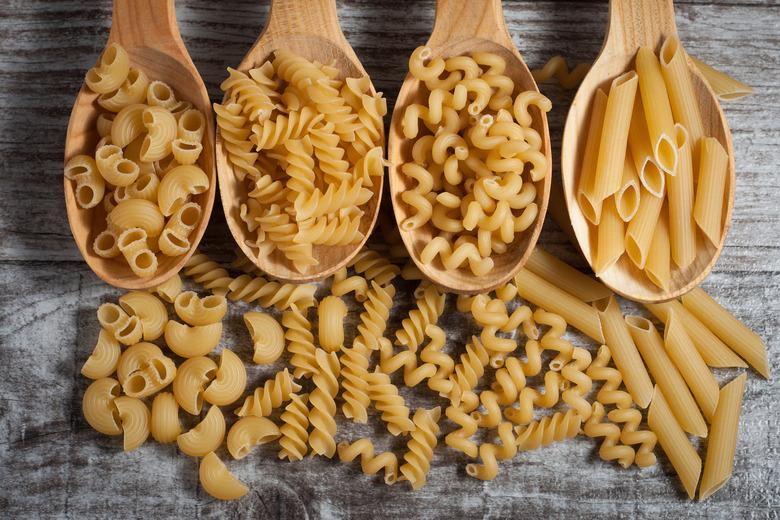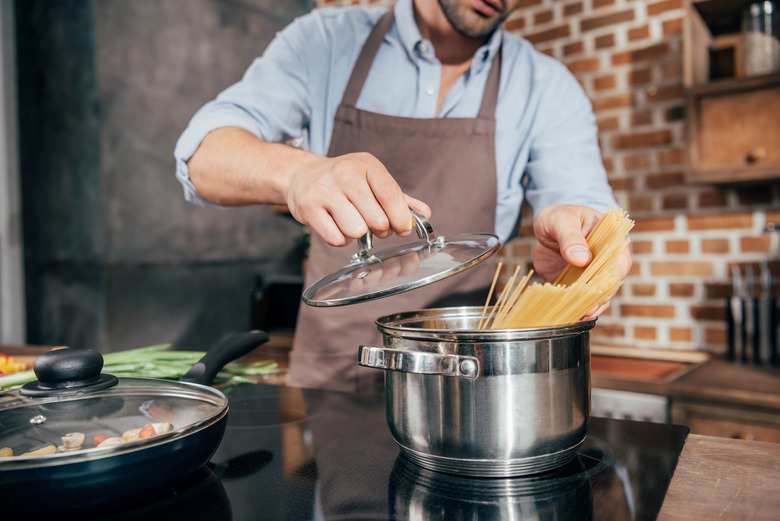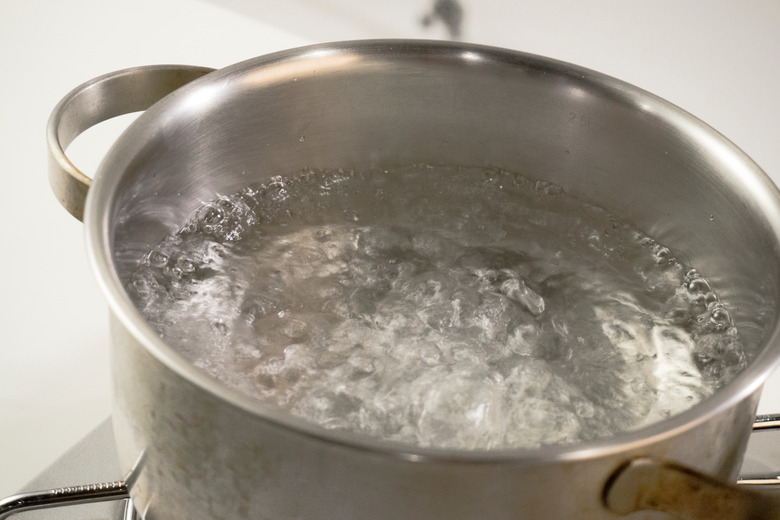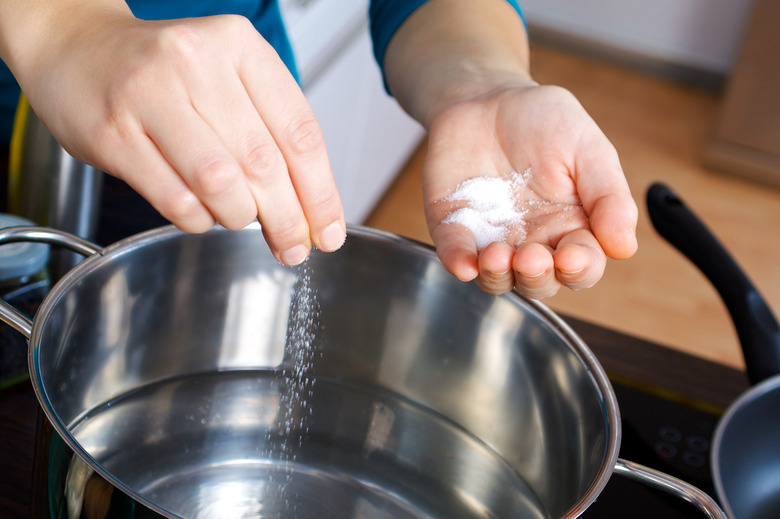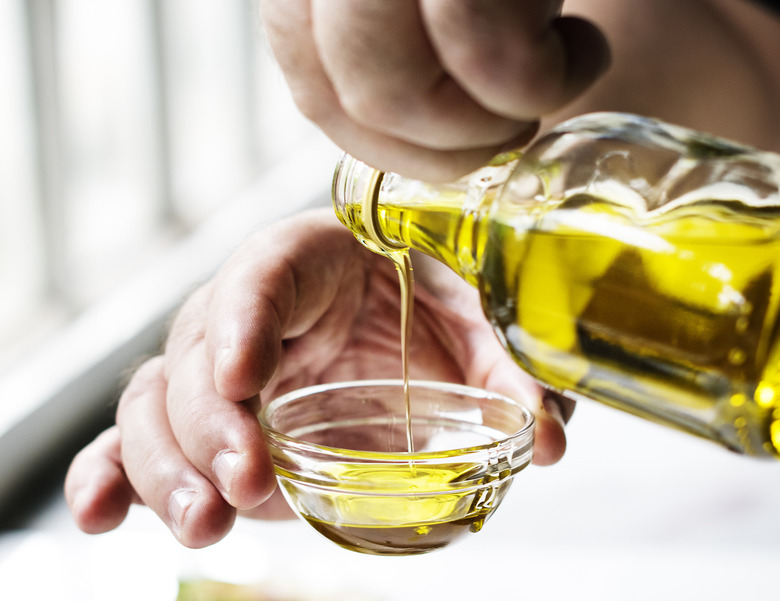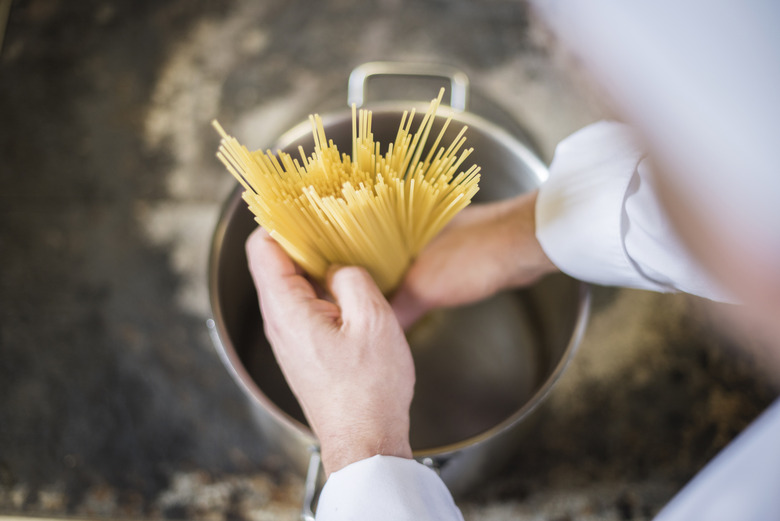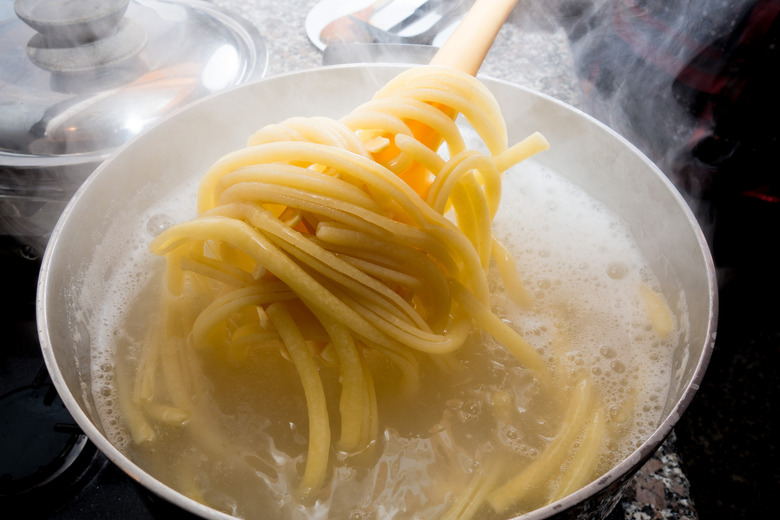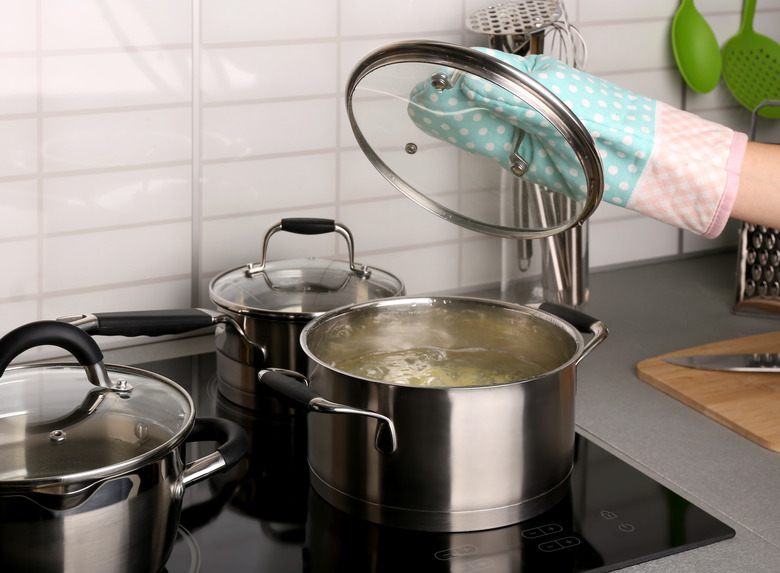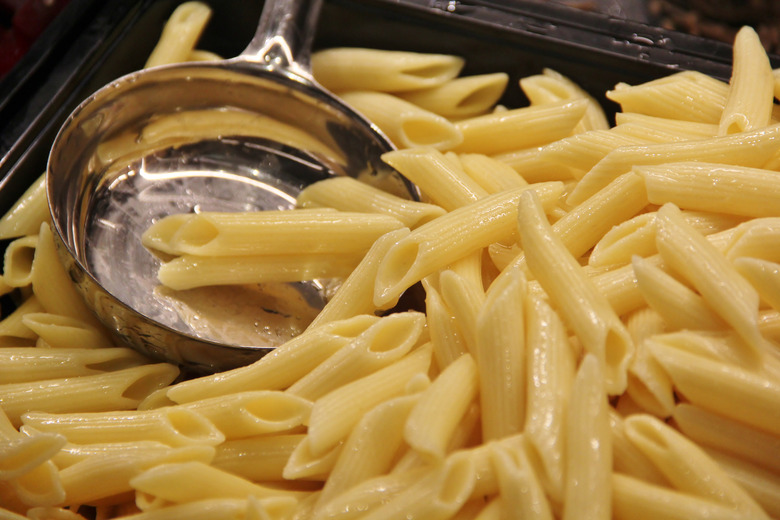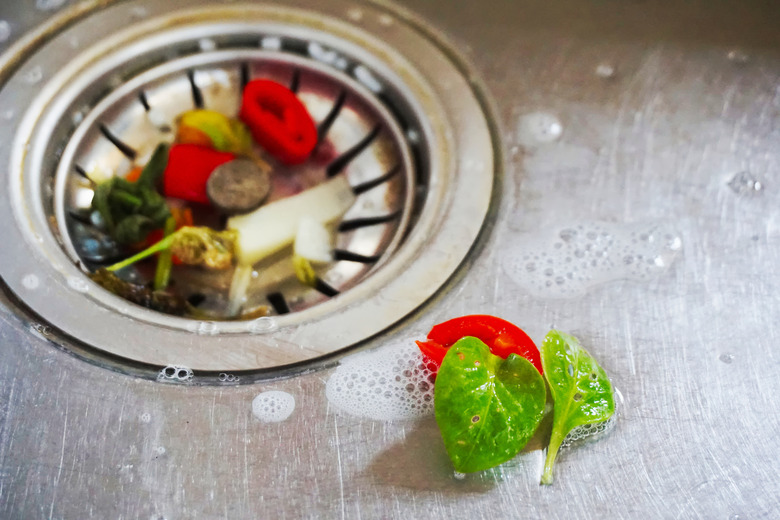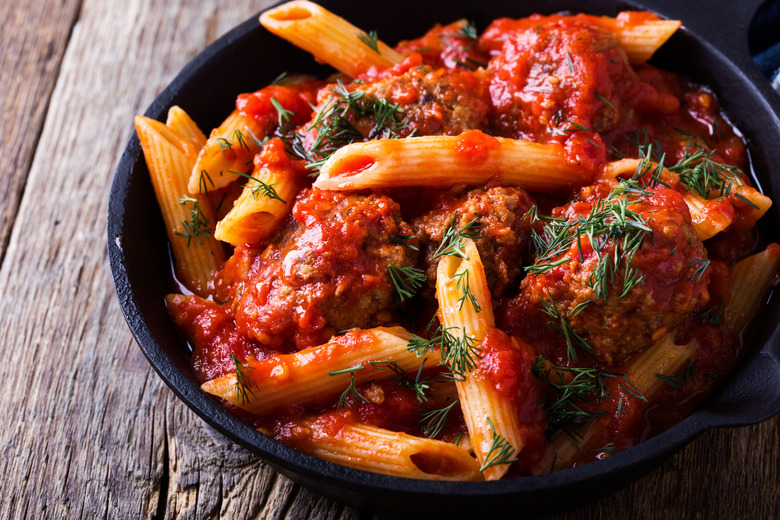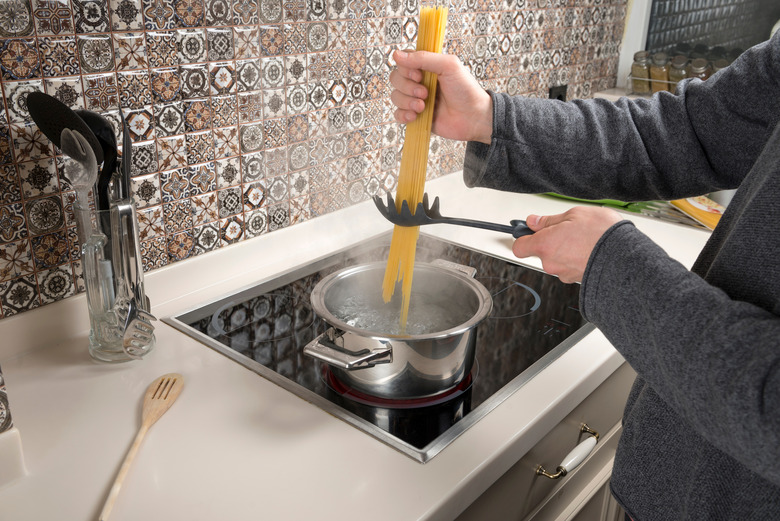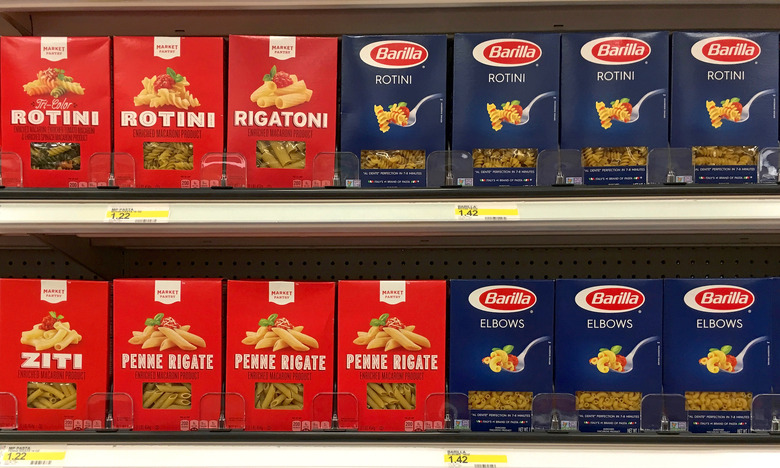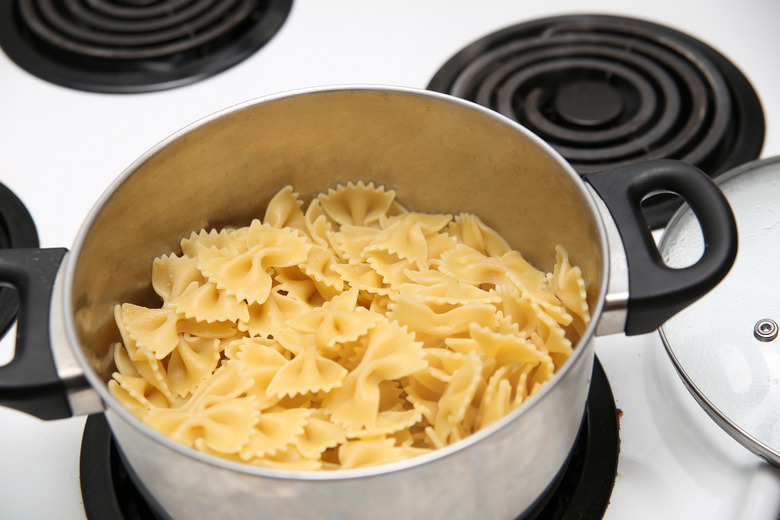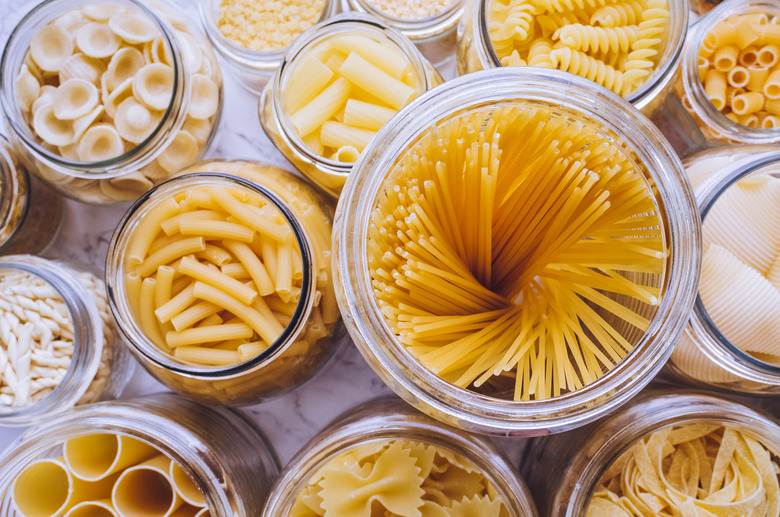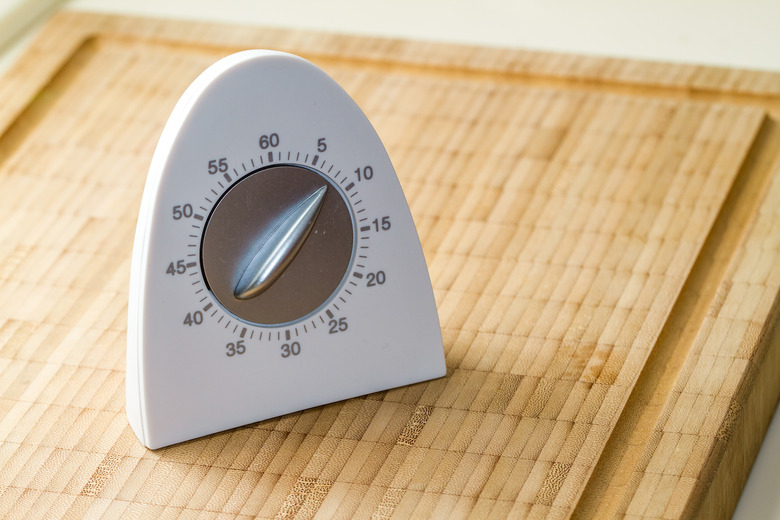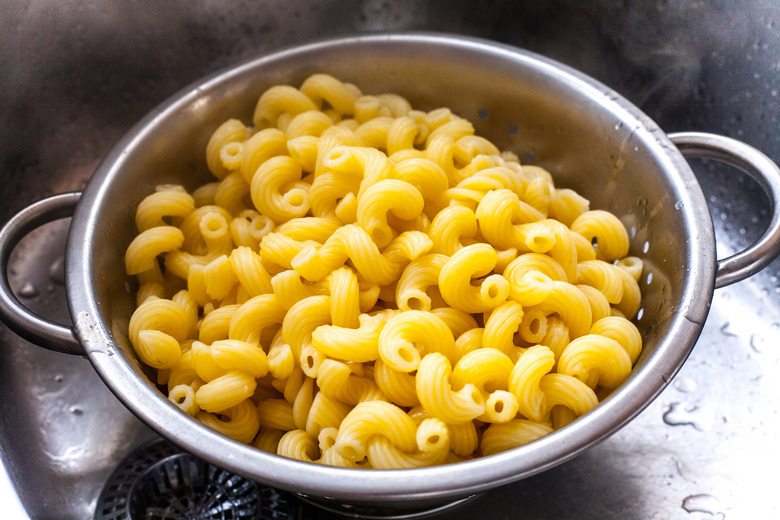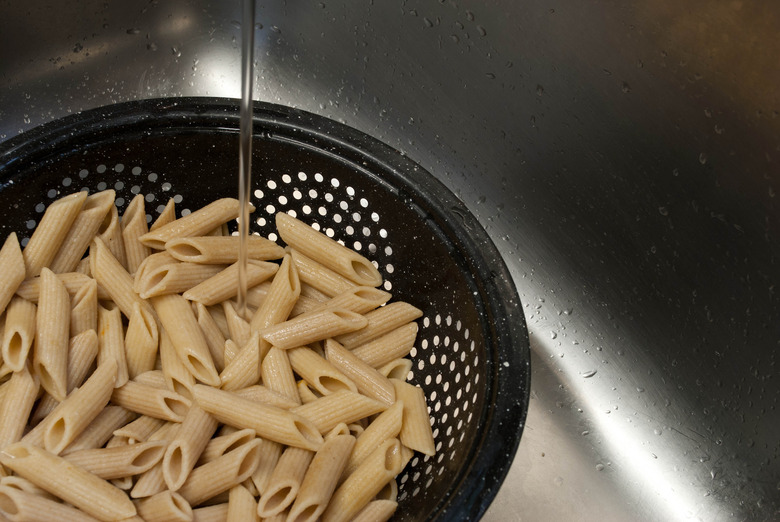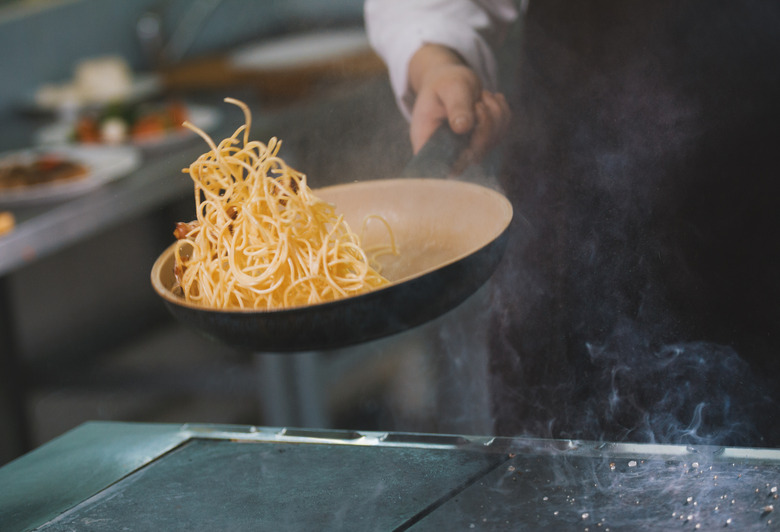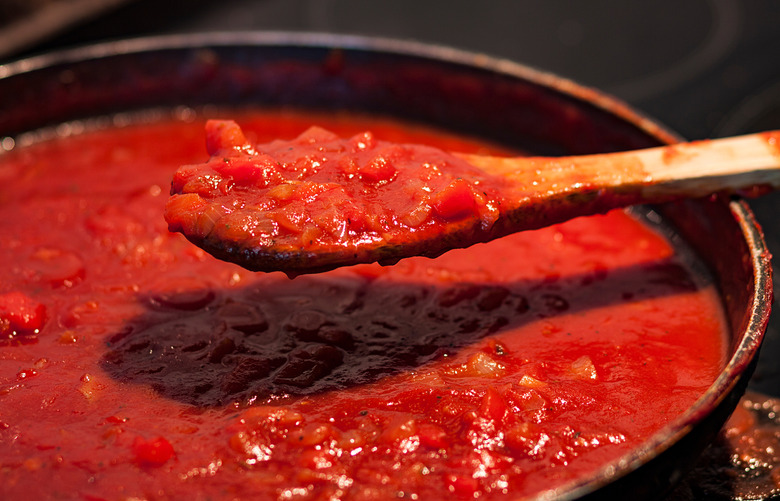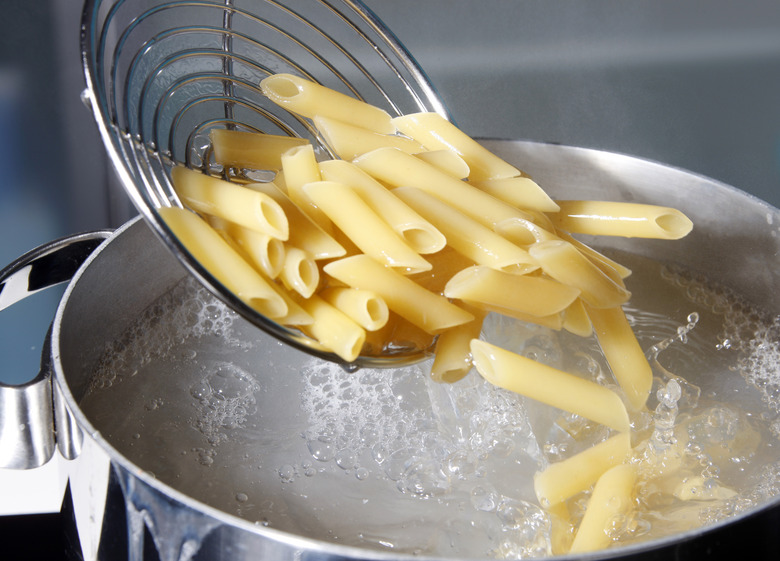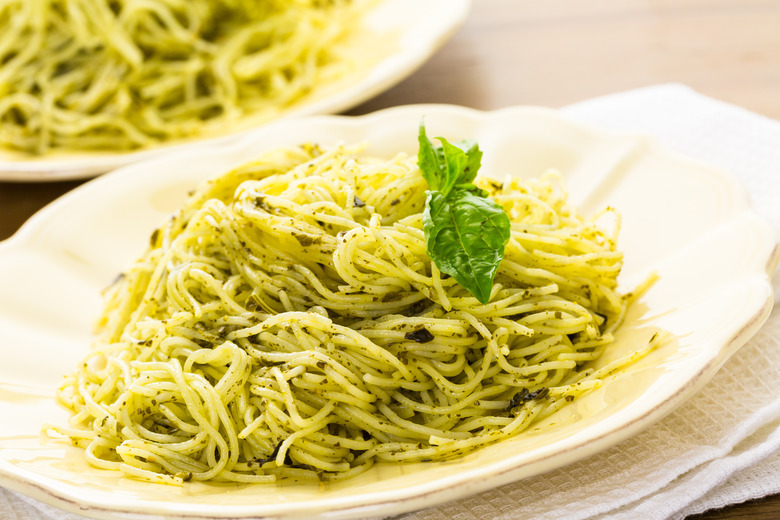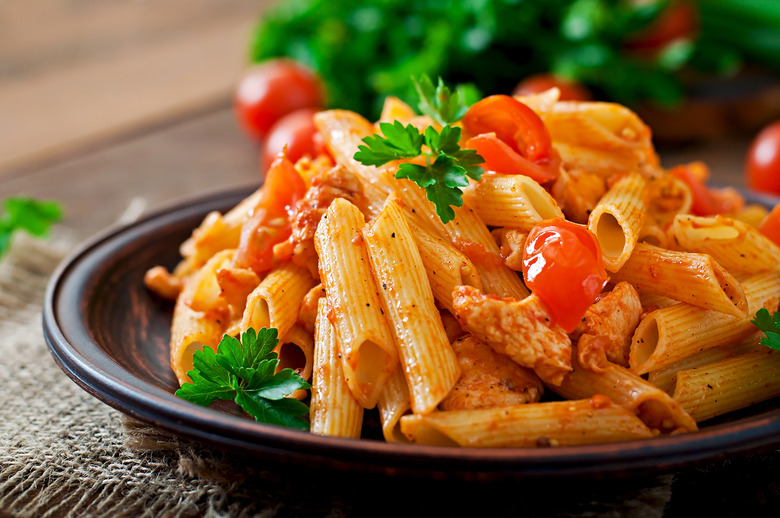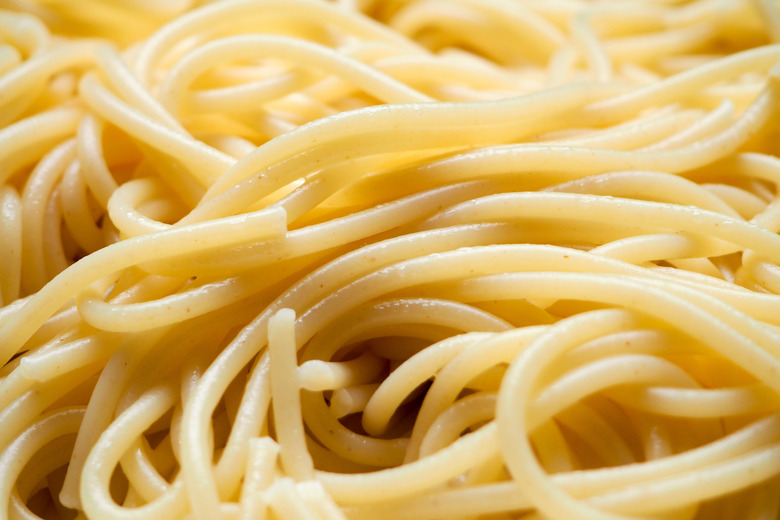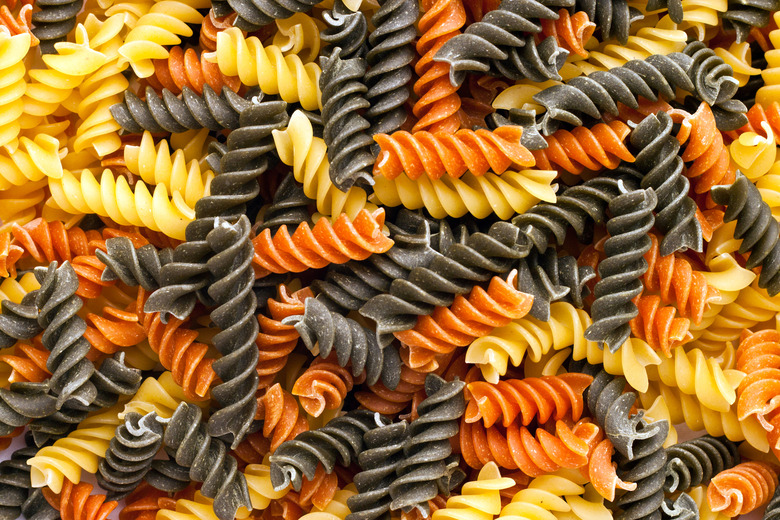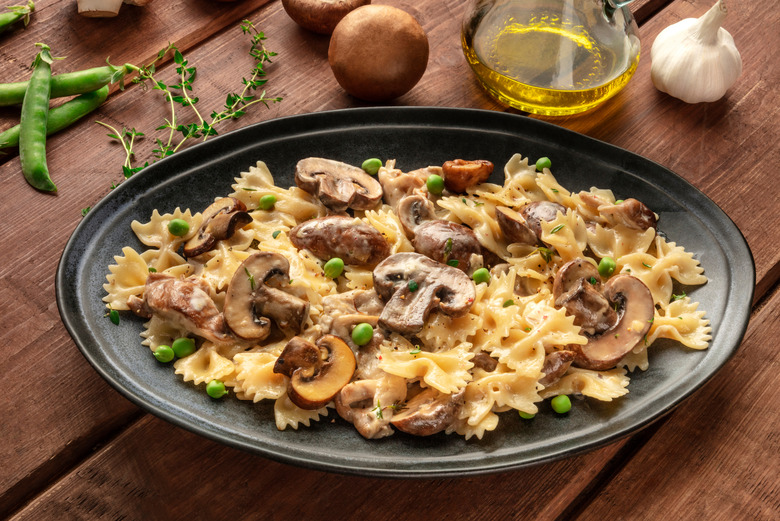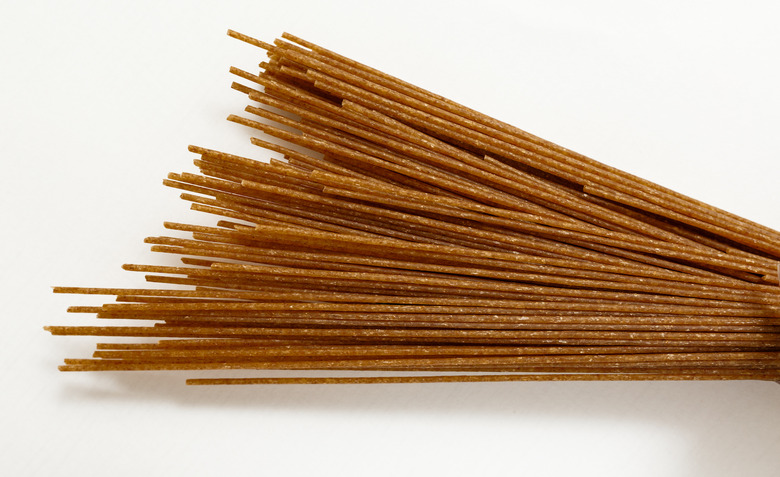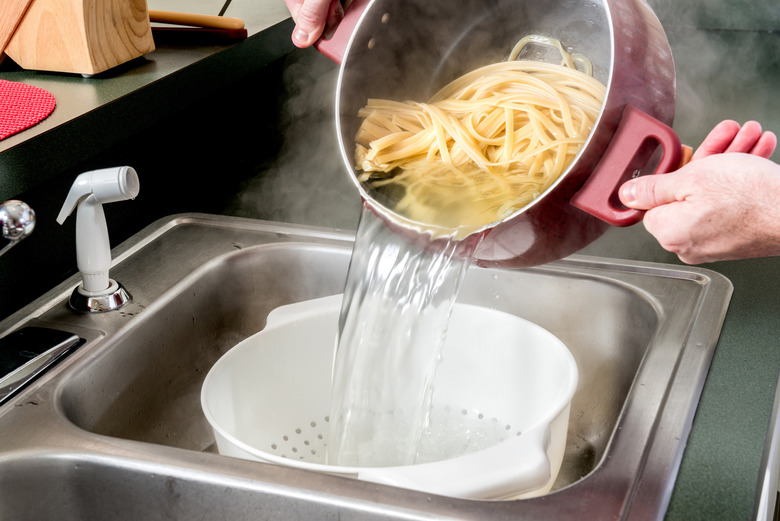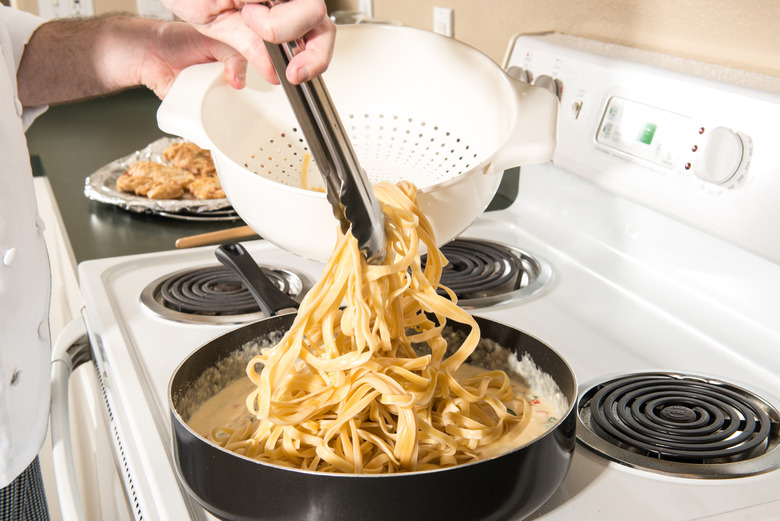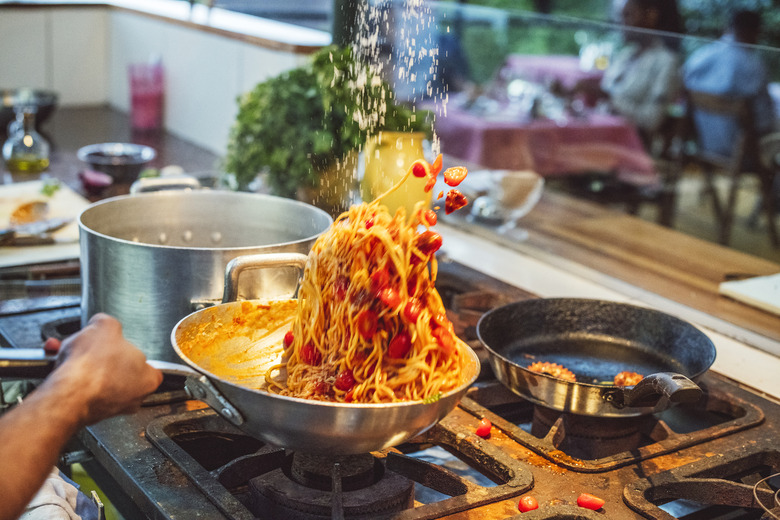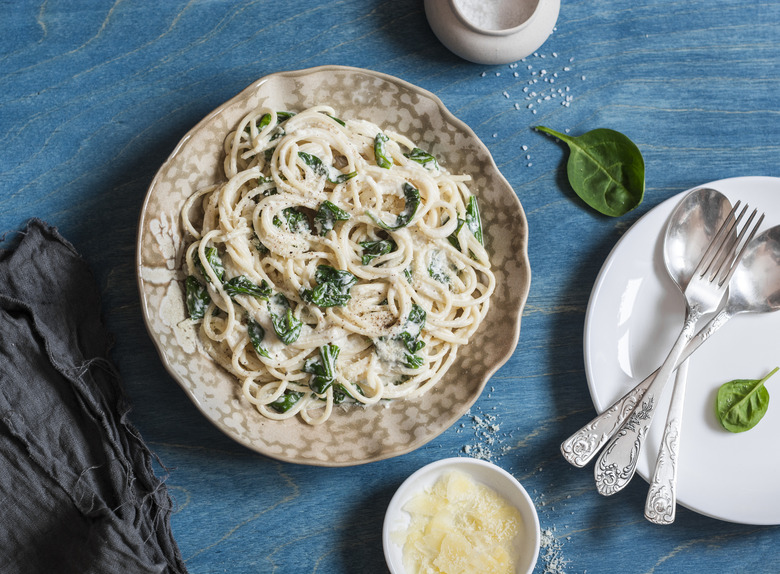How To Cook Pasta Perfectly
Not only is a big bowl of pasta one of the most satisfying dishes to make, but it's also super easy to prepare. Just boil water, add pasta and you're good to go — or so you thought. As it turns out, there are a few things that make a huge difference in the taste and texture of your noodles. Whether you cook pasta every week or once a year, there are a few tricks that will ensure your pasta tastes delicious every time.
Mistake: Using a small pot
Using a smaller pot will cook the pasta faster, right? Wrong. Using a too-small pot will crowd the spaghetti, making the end result a clumpy, gummy and unevenly cooked mess. Once added, the pasta will significantly drop the temperature of the water in the pot. For every pound of pasta, make sure to use at least 5 quarts of water in order to give it the space that it deserves.
Mistake: Starting with hot water
You might think that starting with hot water in your pasta pot will reduce the time it takes to boil. In actuality, whether you start with hot or cold water, that watched pot will take about the same amount of time to come to a boil. This is because cold water absorbs heat faster than hot water. Once the water is hot, the heating rate slows down, so the advantage of starting with hot water is negligible.
Mistake: Not salting the water
So many people consider adding salt to the water an optional step. If you learned any cooking tips from your parents, though, it should have been that salt is crucial to bringing out the flavor and improving the texture of the pasta. In addition to adding flavor, the salt prevents the pasta from becoming slimy while cooking. So, how much salt should be added? You should add about 2 tablespoons of salt for every 5 quarts of water.
Mistake: Adding oil to the water
You've probably heard that adding olive oil to the water when cooking your pasta will prevent the pasta from sticking to itself. In reality, you can cook clump-free pasta if you just cook it in a large pot of rapidly boiling water.
Mistake: Adding the pasta before the water boils
You may have been tempted to add the pasta to the pot just as the first bubble appears on the surface of the water, but you should wait until the water is at a rolling boil. The pasta will drop the temperature of the water, and the longer the pasta sits in water that isn't boiling, the more likely it is that your pasta will turn out clumpy.
Mistake: Not stirring the pasta
Once the pasta is dropped into the water, the boiling will slow for the next minute or two. To keep the pasta from sticking during this time, it is important to stir the pasta until the water comes back to a rolling boil.
Mistake: Not using enough water
Use plenty of water when boiling. If your noodles have nowhere to go, it will be easier for them to stick together, causing clumpy noodles. Remember the 5-quart-per-pound rule — it'll be easier to cook longer noodles like spaghetti and angel hair when there is enough water to submerge them.
Mistake: Over-cooking your pasta
If you've ever felt uncomfortable after eating a bowl of pasta you made, it could be because the noodles were overcooked. Al dente pasta has a lower glycemic index than more-cooked pasta, meaning it'll be digested gradually and won't be as likely to cause a high spike in blood sugar. Overcooked noodles are much more saturated and could cause the dough to become sticky and hard to digest. If you're having digestive issues, might we suggest adding some of these gut-healthy foods to your pasta?
Mistake: Tossing your pasta down the garbage disposal
If you messed up your pasta, use the garbage can, not the garbage disposal. Dry noodles slightly expand when they are hydrated by water, and they'll continue to do so when they're washed down the sink. Additionally, the garbage disposal will mash rather than chop the wet noodles up, causing them to form a doughy paste that can clog your drain.
Mistake: Thinking sauce can take the place of other ingredients
When a pasta dish calls for lots of ingredients, adding more sauce to make up for not having some of the ingredients could detract from the overall taste of the meal. If it means running to the grocery store to grab some freshly grated parmesan, it'll be worth it.
Mistake: Cooking too much of it
If you're usually one to dump half the box of fettuccine in or fill the bottom of the pot with ziti because you're never sure how much to make, this will be your new favorite tip. Barilla recommends about 2 1/8 inches in circumference of long dried noodles (spaghetti, linguine, fettuccine and angel hair) to make about 1 cup of cooked pasta. For farfalle and rigatoni, 3/4 of a cup of dried noodles will make 1 1/4 cups cooked. Half a cup of dried elbow or rotini will also make 1 1/4 cups cooked, whereas 2/3 of a cup of penne or ziti will make 1 1/4 cups cooked. And if you do make too much, there are great ways to use leftovers.
Mistake: Only buying generic
While buying generic pasta is a good way to save money, if you really want to make dinner in feel like dinner out, splurge and buy noodles you find in an Italian deli or fresh noodles from the refrigerated aisle at the grocery store.
Mistake: Leaving it in the pot instead of straining
Even if you turn the heat off, leaving your pot on a hot burner without straining the pasta will continue to cook the noodles and over-saturate them. The result might be a mushy spaghetti mess.
Mistake: Not storing dry noodles properly
Pasta is one of those pantry staples with a long shelf life. If you store it properly — either in an unopened package or in an airtight container — it'll stay fresh for about two years or more. If your package has been opened or moisture has gotten in, the noodles probably won't be fresh for cooking.
Mistake: Following a timer rather than texture
Before we get into how different noodles need different cook times to accommodate their thickness, it's important to not only follow the box instructions, but to also taste the noodles starting a couple minutes before the package advises to find that perfect al dente. One of the reasons your grandma's food tasted better? She trusted the process rather than setting a timer.
Mistake: Cooking all types of pasta the same way
Pasta cooking times can vary by brand, size of the noodle and whether or not the pasta is fresh versus dried. Use the package as a guide for how long to cook your pasta.
Mistake: Leaving the pasta in the colander
If you usually pop your strainer in the sink, dump the pasta into it and then walk away to finish cooking other parts of the meal, don't. A little water on the pasta will help to keep the noodles from clumping, and the starchy water will add body to your sauce.
Mistake: Rinsing the pasta after cooking
There is no need to rinse your noodles after cooking. In fact, rinsing the pasta is a bad cooking habit you should stop now. It will wash away the starches that help the sauces stick, as well as the flavor you worked to produce by salting the water. However, if you are using something like penne for a cold pasta salad, you will need to rinse it to prevent any sticking as it cools.
How to cook pasta
Now that you know what mistakes to avoid, here are some general tips for cooking pasta that will rival the best Italian restaurants in America.
First, cook the sauce
Prepare the sauce while you wait for the pasta water to come to a boil. Cooking sauce first, pasta second will allow the herbs and flavors in the sauce to be more deeply concentrated as they simmer and the sauce will become thicker.
Then, cook the noodles
Leaving your pasta in the colander while you cook the sauce only gives your pasta time to stick and dry out. So, while your sauce is simmering, cook your noodles.
How long to cook angel hair
Angel hair, also called capellini d'angelo, is a fine noodle. It pairs well with light sauces and cooks in about four to five minutes.
How long to cook penne
Penne pasta is shaped in a way that's great for chunkier sauces like a thick meat sauce or cream-based sauce. It will cook in about 11 to 12 minutes.
How long to cook spaghetti
Spaghetti — or pasghetti, if you're cooking with kids — is a classic that goes with any sauce and cooks in nine to 10 minutes.
How long to cook rotini
Whether you prefer a dairy, tomato or oil-based sauce, rotini are twisted noodles that hold sauces well. They cook in seven to eight minutes.
How long to cook farfalle
While the translation means butterfly, farfalle noodles might remind you of bow ties. No matter whether you prefer them in a warm, light sauce or cool in a pasta salad, cook these noodles for 11 to 12 minutes.
Keep in mind that whole grain also cooks differently
Because whole-wheat pasta is made with 100% whole wheat, it cooks differently than noodles made with semolina. Compared to regular penne, whole-wheat penne cooks in nine to 10 minutes.
Reserve pasta water for the sauce
Don't pour all of that flavorful, starchy water down the drain. A restaurant secret that every home cook should know is that a little pasta water added to the sauce will bring the dish together by thickening the sauce.
Finish the pasta in the sauce
There are many pasta dishes that make perfect home-cooked meals, but only if you follow the next couple steps. Drain your pasta when it is still a minute or two away from al dente perfection and let it finish cooking in the sauce. Doing this will allow the pasta to absorb some of the sauce and the end result will be tastier and more full of flavor than if you just dump sauce over some plain pasta.
Add pasta water and butter
Once you've finished the pasta in the sauce, add a little bit of the pasta water back into the pan, along with a knob of butter. Shake up the pan a bit and you'll end up with a gloriously saucy, emulsified and perfectly delicious plate of pasta.
How much sauce should you use?
Toss your pasta in just enough sauce to coat the noodles, adding a splash of the reserved starchy pasta water to help the sauce stick to them. Now that you have all these tips and techniques, you can use them to make a bunch of pasta for leftovers or pre-prepped meals.
More from The Daily Meal
Recipes With Rice for Delicious, Hearty Dinners
Easy Casserole Recipes for Breakfast, Dinner and Everything in Between
Dinner at Home Can Feel Like a Restaurant With These Tips
